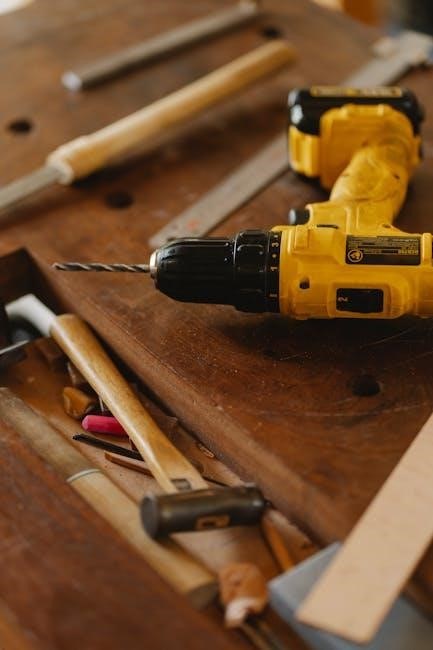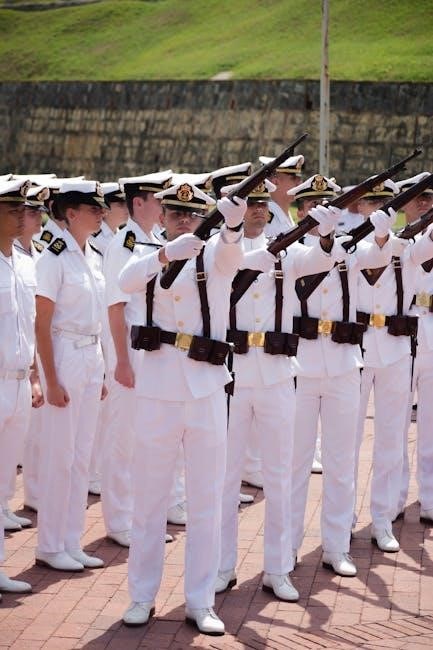The Navy Drill Manual serves as a comprehensive guide for military protocol, ensuring uniformity and discipline․ It outlines procedures for drills, ceremonies, and grooming standards, fostering professionalism and adherence to naval traditions․
1․1 Purpose and Scope of the Manual
The Navy Drill Manual is designed to standardize drill procedures, ensuring consistency across all naval units․ Its purpose is to provide clear guidance on executing drills, ceremonies, and protocols․ The manual covers general drill procedures, ceremonial events, uniform standards, and safety measures․ It serves as a reference for both recruits and experienced personnel, promoting discipline and professionalism․ The scope includes theoretical knowledge and practical exercises, ensuring adherence to naval traditions․ Compliance with the manual is mandatory, as it supports the overall mission of maintaining unit cohesion and operational readiness․
1․2 Importance of Drill in Navy Training
Drill is a cornerstone of Navy training, fostering discipline, teamwork, and precision․ It instills military bearing and prepares sailors for ceremonial and operational duties․ Through repetitive practice, drill builds muscle memory, enabling swift and coordinated responses․ It also promotes esprit de corps, reinforcing unit identity and pride․ Additionally, drill training enhances leadership skills, as sailors learn to follow and execute commands effectively․ The manual ensures these principles are consistently applied, making drill an essential component of naval readiness and tradition․ Its impact extends beyond physical movements, shaping the mental and professional development of all personnel․ Compliance with drill standards is non-negotiable․
1․3 Historical Context of Naval Drill Procedures
Naval drill procedures trace their origins to early maritime traditions, evolving alongside naval warfare tactics․ Historical events, such as the Age of Sail and World War II, influenced modern drill practices․ The manual incorporates timeless principles while adapting to contemporary needs․ Its development reflects the Navy’s commitment to maintaining order and discipline․ By understanding the historical roots, sailors connect with their heritage, ensuring continuity in traditions․ The manual serves as a bridge between past and present, preserving the legacy of naval excellence․ This historical foundation underscores the enduring relevance of drill in shaping naval identity and operational effectiveness․

Historical Background of Naval Drill
Naval drill traces its origins to early maritime traditions, evolving through the Age of Sail․ Historical developments shaped modern procedures, emphasizing discipline and precision․ The manual reflects these roots․
2․1 Evolution of Naval Drill Traditions
Naval drill traditions have evolved significantly since their inception, influenced by maritime history and military advancements․ Early practices emphasized shipboard discipline and efficiency, with drills serving as critical training for battle readiness․ As navies transitioned from sail to steam, drill procedures adapted to new technologies and tactics․ Modern naval drill incorporates precision movements, uniformity, and ceremonial protocols, reflecting the professionalism and heritage of naval forces․ These traditions ensure continuity, fostering unit cohesion and adherence to established standards․ The evolution underscores the enduring importance of drill in maintaining naval excellence and tradition․
2․2 Key Historical Events Influencing Drill Practices
Key historical events have shaped naval drill practices, reflecting technological and tactical advancements․ The Age of Sail introduced manual shiphandling drills, while the shift to steam-powered vessels during the Industrial Revolution brought new procedures․ World Wars I and II accelerated standardization of drills for combat efficiency․ The Cold War era further refined practices, emphasizing precision and coordination․ These events have embedded a culture of discipline and adaptability into naval drill, ensuring readiness for evolving challenges․ Each era contributed to the development of modern drill protocols, blending tradition with innovation to maintain operational excellence․
2․3 Development of Modern Drill Manuals
The development of modern drill manuals reflects the navy’s commitment to standardizing procedures․ In the 20th century, formalized guidelines replaced informal practices, ensuring uniformity across fleets․ The manuals were updated to incorporate technological advancements and evolving operational demands․ Regular revisions in the 1960s and 1990s aligned drills with modern warfare tactics․ Today, these manuals are comprehensive resources, detailing precise movements, commands, and safety measures․ They serve as foundational tools for training, fostering discipline and coordination among personnel․ Continuous updates ensure relevance, adapting to contemporary naval challenges while preserving tradition․

Core Components of the Navy Drill Manual
The manual outlines general drill procedures, ceremonial protocols, uniform standards, and safety measures․ It ensures consistency, discipline, and professionalism across all naval operations and training exercises․

3․1 General Drill Procedures
General drill procedures establish the foundation for military discipline and precision․ They include formation movements, facing, and marching techniques, ensuring synchronization and order․ These procedures emphasize proper alignment, spacing, and timing, fostering teamwork and adherence to command․ Drill instructors guide recruits through repetitive practice to build muscle memory and confidence․ The manual details every movement, from standing at attention to complex maneuvers, ensuring consistency across all units․ These practices prepare personnel for ceremonial events, inspections, and operational scenarios, reinforcing the Navy’s tradition of excellence and professionalism․ Precision in drill fosters unit cohesion and reflects the Navy’s commitment to discipline and readiness․
3․2 Ceremonial Drill Procedures
Ceremonial drill procedures are precise and formal, designed for official events such as parades, flag ceremonies, and inspections․ These drills honor naval traditions and demonstrate military discipline․ They involve intricate movements and commands, requiring meticulous practice to ensure flawless execution․ Proper uniform adherence and synchronized actions are crucial to maintain the Navy’s image․ These ceremonies foster unit pride and esprit de corps, reflecting the Navy’s commitment to heritage and excellence․ Mastery of these procedures is essential for upholding the Navy’s traditions and presenting a unified, professional appearance during formal occasions․
3․3 Uniform and Grooming Standards
Uniform and grooming standards are strictly enforced to maintain professionalism and discipline․ The Navy Drill Manual outlines specific regulations for each uniform, ensuring proper wear and appearance․ Grooming standards include neat haircuts, trimmed facial hair, and clean nails․ Personnel must adhere to these guidelines during drills, ceremonies, and daily duties․ Proper uniform maintenance, such as pressing and cleaning, is also emphasized․ Failure to meet these standards can result in disciplinary action, as they reflect the Navy’s commitment to order and precision․ These standards promote unity and uphold the service’s esteemed image․ Compliance is non-negotiable for all personnel․

3․4 Safety Protocols During Drill Exercises
Safety protocols are essential during drill exercises to minimize risks and ensure a secure training environment․ Proper equipment and attire must be worn at all times․ Drills should commence with warm-up routines to reduce the likelihood of injuries․ Supervisors must closely monitor activities, and any unsafe conditions should be promptly addressed․ Emergency response plans, including first aid, must be readily available․ Strict adherence to safety guidelines is mandatory, and any deviations should be immediately corrected․ Regular equipment inspections and hazard assessments are also critical to maintaining a safe environment․ Safety remains a top priority to protect personnel and uphold effective training standards․
Drill Commands and Procedures
Drill commands and procedures form the foundation of naval discipline, ensuring precise execution and unity in movement․ They include basic and advanced instructions, guiding personnel through maneuvers and ceremonies․ Mastering these commands is essential for maintaining order and professionalism․
4․1 Basic Drill Commands
Basic drill commands are foundational to naval procedures, ensuring discipline and unity․ Commands like “Attention,” “At Ease,” “Right Face,” and “Left Face” guide personnel movements․ “Forward March” and “Halt” control pacing, while “Present Arms” and “Order Arms” manage weapon handling․ These commands are executed with precision, maintaining formation integrity․ Drill instructors emphasize voice tone, clarity, and timing to ensure immediate compliance․ Mastery of these commands fosters discipline, teamwork, and professionalism, reflecting the Navy’s commitment to order and tradition․ Proper execution is vital for ceremonies, parades, and daily operations, reinforcing the core values of naval service․
4․2 Advanced Drill Commands
Advanced drill commands build on basic techniques, introducing complexity and precision․ Commands like “Column Right/Left,” “Change Step,” and “Mark Time” require synchronized movement and coordination․ “Right/Left Wheel” and “About Face” involve turning and realigning formations seamlessly․ These commands are crucial for parades, ceremonies, and tactical maneuvers․ Drill instructors emphasize fluid execution and immediate response to maintain unit cohesion․ Advanced commands refine teamwork, discipline, and professionalism, preparing personnel for high-profile events and operational scenarios․ Mastery of these commands underscores the Navy’s commitment to precision and excellence in all drills and ceremonies․
4․3 Execution of Drill Movements
The execution of drill movements requires precision, timing, and adherence to established protocols․ Proper body alignment, posture, and foot placement are critical to maintain uniformity․ Movements such as “Attention,” “At Ease,” and “Present Arms” must be performed sharply and in unison․ Drill instructors emphasize the importance of rhythm and coordination, often achieved through repetitive practice․ The execution of these movements fosters discipline, teamwork, and a sense of professionalism․ Correct technique ensures safety and prevents injuries, while also projecting the Navy’s tradition of excellence․ Precision in execution reflects the unit’s readiness and adherence to military standards․
4․4 Common Mistakes to Avoid
Common mistakes during drill exercises often stem from poor posture, misalignment, or improper timing․ Cadets may fail to maintain consistent spacing or forget to keep their eyes forward․ Incorrect foot placement, such as heels not aligned, can disrupt unity․ Rushing or lagging behind the rhythm is another frequent error․ Additionally, improper handling of equipment, like holding the rifle incorrectly, can lead to safety hazards․ Ignoring commands or losing focus can cause individuals to fall out of step․ Addressing these issues early in training helps build discipline and ensures smooth, precise executions of drill movements․

Ceremonial Procedures
Ceremonial procedures symbolize respect, tradition, and unity within the Navy․ Precision and uniformity are crucial, reflecting discipline and heritage in every execution․
5․1 Flag Ceremonies and Etiquette
Flag ceremonies are integral to naval tradition, symbolizing patriotism and respect․ The proper raising, lowering, and folding of the flag are meticulously choreographed․ Sailors must ensure the flag is raised at dawn and lowered at sunset, folding it into a precise triangular shape․ During ceremonies, all personnel must salute when the anthem plays․ The flag must never touch the ground or be mishandled․ Proper etiquette includes facing the flag during ceremonies and ensuring it is illuminated at night․ These protocols uphold the Navy’s honor and reflect its commitment to heritage and discipline․
5․2 Parade and Inspection Procedures
Parade and inspection procedures emphasize precision and discipline․ Personnel must align in formation with exact spacing, maintaining posture and eye contact․ Inspections begin with a command to ” Attention” and “Present Arms,” showcasing uniformity․ The inspecting officer evaluates grooming, uniform accuracy, and equipment condition․ Rifles and swords are held at specific angles during presentation․ Marching movements must be synchronized, with cadence maintained․ These ceremonies foster unit cohesion, pride, and adherence to naval standards, reflecting the professionalism expected of sailors in formal settings․ Proper execution ensures a polished and respectful presentation of the unit․
5․3 Sword and Rifle Drill Techniques
Sword and rifle drill techniques require precision and coordination․ Swords are drawn with a swift, controlled motion, following specific angles for parries and thrusts․ Rifle drills involve shouldering, presenting, and port arms, executed in unison․ Techniques emphasize proper grip, stance, and alignment․ Historical drills, such as the cutlass exercise, honor naval traditions․ Instructors ensure synchronized movements and adherence to safety protocols․ These drills develop discipline, teamwork, and martial proficiency, reflecting the Navy’s commitment to precision and heritage․ Proper execution demonstrates mastery of both weapon handling and ceremonial excellence, embodying naval professionalism․ Regular practice maintains proficiency and unit cohesion․
5․4 Funeral and Memorial Ceremonies
Funeral and memorial ceremonies are solemn events requiring precise drill execution․ These ceremonies honor deceased service members and their families․ The Navy Drill Manual outlines specific protocols for pallbearers, flag folding, and rifle volleys․ Personnel must maintain a respectful demeanor, adhering to uniform standards and ceremonial procedures․ The playing of Taps and the presentation of the flag to the next of kin are critical moments․ Drill teams ensure synchronized movements during processions and graveside services․ These ceremonies reflect the Navy’s commitment to honoring its members with dignity and respect, upholding traditions that pay tribute to their service and sacrifice․

Uniform and Grooming Standards
Uniform and grooming standards ensure professionalism and unity among personnel․ Regulations specify acceptable hairstyles, facial hair, and attire․ Proper maintenance of uniforms is mandatory for all ranks․ Non-compliance may result in disciplinary action․
6․1 Official Uniform Regulations
Official uniform regulations outline the specific attire and appearance standards for Navy personnel․ These regulations ensure consistency and professionalism across all ranks․ They cover service uniforms, dress uniforms, and working uniforms, specifying acceptable colors, fabrics, and designs․ Personnel must wear uniforms correctly, with proper fit and cleanliness․ Insignias, badges, and ribbons must be displayed accurately to reflect individual achievements and rank․ Adherence to these regulations is mandatory, as it fosters unity and respect within the naval tradition․ Failure to comply may result in disciplinary measures, emphasizing the importance of maintaining a polished and respectful appearance at all times․
6․2 Proper Grooming and Appearance
Proper grooming and appearance are essential for maintaining discipline and professionalism in the Navy․ Personnel must adhere to strict standards, including neat haircuts, trimmed facial hair, and clean nails․ Personal hygiene is mandatory, with regular showers and use of deodorant expected․ Posture and cleanliness of uniforms are also critical, reflecting individual and unit pride․ These practices foster a unified and respectful image, aligning with naval traditions․ Non-compliance can lead to disciplinary action, reinforcing the importance of maintaining a polished appearance that supports operational readiness and morale․
6․3 Uniform Maintenance and Care
Uniform maintenance is crucial for upholding naval standards and projecting professionalism․ Sailors must regularly inspect uniforms for wear, tears, and stains, addressing issues promptly․ Cleaning should follow specific guidelines, avoiding harsh chemicals that may damage materials․ Proper storage in clean, dry environments prevents wrinkles and moisture damage․ Uniforms must be tailored to fit correctly, with all insignia and ribbons securely attached․ Regular polishing of shoes and equipment ensures a sharp appearance․ Adherence to these practices reflects pride in service and alignment with naval traditions, while neglecting maintenance can result in disciplinary action for failing to meet standards․
6․4 Consequences of Non-Compliance
Failure to adhere to uniform and grooming standards can result in disciplinary actions․ Initial infractions may lead to counseling or verbal warnings, while repeated offenses can escalate to written warnings or extra duties․ Severe violations may result in confinement to quarters, loss of privileges, or even reduction in rank․ Non-compliance reflects poorly on both the individual and their unit, undermining discipline and professionalism․ Consistent disregard for standards can harm career advancement and may lead to administrative separation in extreme cases․ Compliance is non-negotiable, as it upholds the Navy’s tradition of excellence and unity․

Training and Practice
Navy drill training emphasizes structured sessions to master procedures, ensuring precision and unity․ Regular practice reinforces discipline and readiness, fostering professionalism and cohesion among personnel․
7․1 Initial Drill Training for New Recruits
Initial drill training for new recruits focuses on mastering fundamental movements, such as attention, at ease, and facing movements․ Recruits learn basic marching techniques, including quick and slow paces, and group drill formations․ Training emphasizes teamwork, discipline, and precision․ Instructors demonstrate proper posture, alignment, and coordination to ensure unity in execution․ This foundational phase builds confidence and familiarity with drill procedures, preparing recruits for advanced training․ Safety and adherence to protocols are stressed to prevent injuries during practice․ The goal is to create a cohesive unit capable of performing drills with professionalism and pride․
7․2 Advanced Drill Training for Experienced Personnel
Advanced drill training refines skills for experienced personnel, focusing on complex movements and leadership roles․ Drills emphasize precision, coordination, and fluid transitions between commands․ Personnel practice ceremonial procedures, such as sword and rifle handling, and intricate formation changes․ Tactical drills simulate real-world scenarios, enhancing teamwork and decision-making․ Training also covers the role of drill leaders, teaching how to guide and correct others effectively․ The curriculum challenges experienced members to achieve higher standards of performance and discipline, ensuring they can lead by example and execute drills flawlessly during formal events or operational situations․
7․3 Role of Drill Instructors
Drill instructors are pivotal in shaping recruits’ discipline and professionalism․ They teach precise execution of drill movements, military protocol, and leadership skills․ Instructors emphasize repetition and attention to detail to build uniformity and pride․ Their role extends beyond physical training, fostering mental resilience and teamwork․ They also mentor experienced personnel, refining advanced techniques and ensuring adherence to manual standards․ Drill instructors embody the Navy’s traditions, inspiring excellence and esprit de corps․ Their guidance is essential for producing well-prepared, disciplined sailors capable of upholding the Navy’s high standards in ceremonies and operational duties alike;
7․4 Best Practices for Effective Drill Practice
Effective drill practice requires consistency, precision, and focus․ Start with basic movements to build a strong foundation․ Use the Navy Drill Manual as a guide to ensure adherence to standards․ Practice in a well-spaced, open area to allow for proper formation and movement execution․ Immediately correct errors to prevent habits from forming․ Incorporate drills into daily routines to enhance muscle memory and teamwork․ Use commands clearly and consistently, and encourage feedback from instructors․ Conclude each session with a review of key points to reinforce learning and maintain accountability․

Safety Protocols
The Navy Drill Manual emphasizes safety protocols to prevent injuries during exercises․ Proper equipment checks, risk assessments, and emergency preparedness are essential to ensure a secure training environment․
8․1 Safety Measures During Drill Exercises
Safety is paramount during Navy drill exercises․ Personnel must wear proper attire, including approved footwear and personal protective equipment when required․ Equipment inspection before use is mandatory to prevent accidents․ Drills should be conducted on level, clear surfaces to minimize trip hazards․ Supervision by experienced instructors ensures adherence to safety protocols․ Participants are encouraged to report any physical discomfort or potential risks․ Proper warm-up routines are essential to reduce injury risks․ Adhering to established guidelines ensures a secure environment for all involved in drill exercises․
8․2 Emergency Procedures
Emergency procedures during Navy drill exercises are critical to ensure prompt and effective responses․ In case of an injury, immediate first aid should be administered, and medical personnel notified․ Fire drills require evacuation routes to be clearly marked and practiced․ Communication during emergencies must be clear and concise, following established protocols․ Drill instructors are trained to assess situations and direct appropriate actions․ Emergencies are documented post-incident for review and prevention․ Adherence to these procedures minimizes risks and ensures safety, reflecting the Navy’s commitment to protecting personnel during training exercises․
8․3 Injury Prevention
Injury prevention is a top priority in Navy drill exercises to maintain readiness and reduce downtime․ Proper warm-ups, stretching, and cool-downs are essential to prevent muscle strains․ Drill instructors emphasize correct posture and technique to avoid overexertion․ Trainees are encouraged to report any discomfort or pain early to prevent minor issues from escalating․ Personal protective equipment is mandated for high-risk drills․ Regular fitness assessments ensure personnel are physically prepared; Education on proper lifting and movement techniques is also provided․ These proactive measures foster a safer training environment and reduce the likelihood of injuries during drills․
8․4 Reporting Safety Violations
Reporting safety violations is critical to maintaining a secure and disciplined environment during drill exercises․ Personnel are required to immediately report any unsafe practices or hazards to their superiors․ A standardized reporting process ensures incidents are documented and addressed promptly․ All reports are investigated thoroughly, and corrective actions are implemented to prevent future occurrences․ Confidentiality is maintained to encourage honest reporting without fear of reprisal․ Timely and accurate reporting helps uphold safety standards and protects the well-being of all participants․ This accountability fosters a culture of safety and mutual responsibility within the Navy drill community․

Disciplinary Actions
Disciplinary actions ensure accountability for misconduct, maintaining high standards and unit cohesion․ Procedures are formalized to address violations fairly, with consequences varying by severity․ Accountability strengthens discipline․
9․1 Consequences of Drill Infractions
Drill infractions result in corrective actions to maintain discipline and adherence to standards․ Minor violations may lead to informal correction or additional duties, while more severe offenses can result in formal disciplinary measures, such as non-judicial punishment․ Repeated or egregious infractions may lead to reduction in rank, loss of privileges, or even administrative separation․ The Navy emphasizes accountability, ensuring that disciplinary actions are fair, consistent, and align with established regulations․ These consequences reinforce the importance of proper drill execution and adherence to the manual’s guidelines․
9․2 Disciplinary Procedures
Disciplinary procedures for drill infractions follow standardized protocols to ensure fairness and consistency․ Commanding officers conduct thorough investigations, often involving witness statements and performance reviews․ Depending on the severity, actions may include verbal or written reprimands, extra duties, or formal non-judicial punishment․ More serious cases are referred to higher authorities for court-martial proceedings․ Documentation of incidents and corrective measures is maintained in service records․ These procedures aim to address misconduct while providing opportunities for improvement, ensuring accountability and maintaining unit cohesion and operational readiness․
9․3 Rehabilitation and Re-training
Rehabilitation and re-training programs are designed to address deficiencies and restore personnel to full performance standards․ These programs are tailored to individual needs, focusing on areas requiring improvement․ Supervised by experienced instructors, sailors undergo targeted training to correct drill errors and improve adherence to protocols․ Mentorship and practical exercises are key components, ensuring a comprehensive understanding of expectations․ Progress is closely monitored, with regular evaluations to assess improvement․ The goal is to equip personnel with the skills and confidence needed to meet naval standards, fostering accountability and operational excellence within the unit․
The Navy Drill Manual ensures adherence to standards, fostering unity and operational effectiveness through precise drill protocols, ultimately upholding the Navy’s discipline, tradition, and readiness․
10․1 Summary of Key Points
The Navy Drill Manual is a comprehensive guide ensuring adherence to standardized procedures, emphasizing discipline, unity, and operational readiness․ It outlines the purpose and scope of drill, its historical significance, and core components such as general and ceremonial procedures, uniform standards, and safety protocols․ The manual also details drill commands, execution of movements, and common mistakes to avoid․ Training practices, disciplinary actions, and the role of drill instructors are highlighted, underscoring the importance of precision and adherence to tradition․ By following the manual, personnel uphold the Navy’s legacy of professionalism and preparedness․
10․2 Final Thoughts on the Importance of Drill
Drill is the backbone of naval discipline, fostering unity, precision, and readiness․ It instills pride, accountability, and teamwork, essential for operational success․ By mastering drill, sailors embody the Navy’s values and heritage․ Drill prepares individuals for the rigors of service, ensuring they can perform under pressure with confidence and cohesion․ Its principles extend beyond ceremonies, influencing everyday conduct and decision-making․ Embracing drill traditions strengthens the Navy’s identity and ensures a legacy of professionalism and excellence․


